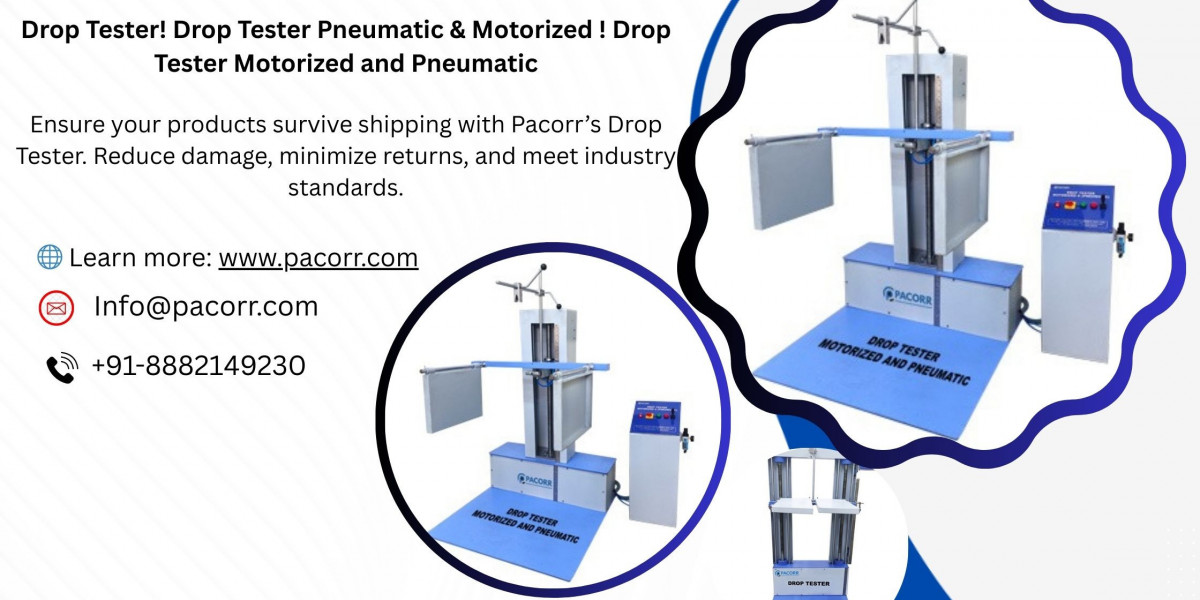What is a Drop Tester?
A Drop Tester is a machine designed to simulate the impact of a product falling during transportation or handling. By dropping a packaged item from varying heights and orientations, the Drop Tester measures its ability to withstand shocks without damage. This tool is essential for manufacturers, packaging companies, and logistics providers looking to ensure that their products arrive at their destination in perfect condition.
How Does a Drop Tester Work?
The Drop Tester functions by allowing a package to be dropped from a specific height, simulating the real-world scenario of a package falling during transit. The machine is equipped with sensors and controls to monitor the impact force and the height from which the package is dropped. The drop height can be adjusted based on the size, weight, and fragility of the product being tested.
Key features of a Drop Tester include:
Adjustable drop heights: The machine can drop packages from varying heights to simulate different fall scenarios.
Multiple orientations: Packages can be tested in different orientations (e.g., top, side, corner) to simulate different types of impacts during transportation.
Data analysis: Many Drop Testers are equipped with data logging capabilities to record the impact forces and provide detailed results for analysis.
Why is a Drop Tester Important?
A Drop Tester is a crucial tool for several reasons:
1. Ensures Product Safety
The primary function of a Drop Testing is to assess the safety of the packaging. By simulating various impact scenarios, it helps manufacturers ensure that their packaging will protect the product from damage during transit. This is particularly important for fragile items such as electronics, glass products, or food items.
2. Reduces Costs
By identifying weak points in packaging, a Drop Tester helps companies reduce product damage during shipping. This leads to fewer returns, fewer damaged goods, and lower costs associated with re-packaging or replacing items. In the long run, this saves both time and money for businesses.
3. Improves Customer Satisfaction
Damaged products can result in dissatisfied customers and negative reviews. By using a Drop Tester to verify packaging durability, manufacturers can reduce the risk of sending out damaged goods, leading to improved customer satisfaction.
4. Meets Industry Standards
Many industries have specific packaging requirements for product transportation. Using a Drop Tester ensures that products meet these standards, including those set by organizations such as ASTM (American Society for Testing and Materials) and ISO (International Organization for Standardization).
Types of Drop Test Procedures
There are various drop test procedures that can be conducted using a Drop Tester to evaluate packaging performance under different conditions.
1. Free Fall Drop Test
The most basic type of test, the free fall drop test, involves dropping a package from a fixed height onto a flat surface. The impact is measured to see if the packaging can absorb the shock without causing product damage.
2. Edge Drop Test
In this test, the package is dropped so that one of its edges makes contact with the ground first. This simulates the scenario where a package might be tipped over or dropped at an angle during transit.
3. Corner Drop Test
The corner drop test involves dropping the package so that one of its corners strikes the ground. This is one of the most severe tests, as the impact force is concentrated at a single point on the package.
4. Side Drop Test
This test simulates a scenario where the package lands on its side, allowing for the measurement of its ability to withstand impacts on larger surfaces.
Benefits of Using a Drop Tester
Using a Drop Tester offers numerous benefits to manufacturers and logistics companies. Some of the key advantages include:
1. Improved Packaging Design
By identifying weak spots in the packaging, manufacturers can make necessary adjustments to improve packaging strength and resilience. Whether it's adding more cushioning material or changing the structure of the box, the Drop Tester helps create packaging that can better protect the product.
2. Enhanced Compliance
Many industries, such as pharmaceuticals and electronics, require their packaging to meet specific transit-related standards. A Drop Tester helps companies adhere to these standards, ensuring compliance with industry regulations and guidelines.
3. Accurate Testing
Unlike manual testing, which can be subjective, a Drop Tester provides accurate and repeatable results, ensuring consistent testing for all packages.
4. Helps in Quality Control
Quality control is essential to ensure that products meet the required standards before they reach the market. The Drop Tester Price provides a quick and efficient way to verify that packaging can withstand the demands of shipping, helping to reduce the chances of defective products reaching consumers.
Choosing the Right Drop Tester
When selecting a Drop Tester, there are several factors to consider, including:
Test Height Range: Ensure that the machine can handle the height range required for your products.
Package Weight Capacity: The Drop Tester should be capable of testing products of varying weights.
Type of Testing: Choose a machine that offers the drop test procedure most relevant to your needs (e.g., free fall, corner, or edge drop tests).
Data Logging and Analysis: Some Drop Testers come with data logging features that record impact forces and test results. This can be valuable for ongoing quality analysis.
Conclusion
A Drop Tester is an indispensable tool for testing packaging durability. By simulating real-world shipping conditions, it helps manufacturers ensure that their packaging will protect products during transportation. This leads to safer products, lower costs, improved customer satisfaction, and compliance with industry standards. Whether you're involved in packaging, logistics, or product manufacturing, investing in a Drop Tester is essential for maintaining packaging quality and ensuring the safe delivery of your products.








